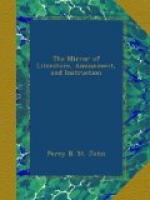* * * * *
SPIRIT OF DISCOVERY.
* * * * *
POTTERY.[11]
(Concluded from page 326.)
Wedgewood’s Staffordshire Ware.
[11] By Mr. A. Aikiu, in Trans. Soc. Arts.
Lastly is the manufacture of those species of glazed pottery known by the general name of Staffordshire ware. The date of this ware is about sixty years ago, and it unquestionably originated with the late Mr. Wedgewood. It not only originated with him, but was carried by his knowledge, his skill, and his perseverance, to a degree of excellence which, in several points, has never been surpassed, and in some has never been equalled.
He perceived that the defects of the delft ware, at that time the only species of pottery employed for common domestic purposes, were the softness and looseness of texture of its body, which obliged the potter to make it thick and clumsy and heavy, in order to ensure to it a moderate durability; and that its porousness, as well as its dirty grey colour, required a thick coating of white enamel, which added still farther to its bulk and weight, and which, consisting for the most part of lead and arsenic, was hardly safe for culinary use.
He began, therefore, by inventing a body for earthenware, which at the same time should be white, and capable of enduring a very high degree of heat without fusion, well knowing that the hardness of the ware depended on the high firing to which it has been subjected. For this purpose, rejecting the common clays of his neighbourhood, he sent as far as Dorsetshire and Devonshire for the whiter and purer pipe-clays of those counties. For the siliceous ingredient of his composition he made choice of chalk-flints, calcined and ground to powder.
It might be supposed that white sand would have answered his purpose equally well, and have been cheaper; but, being determined to give the body of his ware as great a degree of compactness as possible, it was necessary that the materials should be reduced to the state almost of an impalpable powder; and calcined flints are much more easily brought to this state by grinding than sand would be. The perfect and equable mixture of these two ingredients being a point of great importance, he did not choose to trust to the ordinary mode of treading them together when moist, but having ground them between stones separately with water to the consistence of cream, he mixed them together in this state by measure, and then, evaporating the superfluous water by boiling in large cisterns, he obtained a composition of the most perfect uniformity in every part. By the combination of these ingredients, in different proportions, and exposed to different degrees of heat, he obtained all the variety of texture required, from the bibulous ware employed for glazed articles, such




